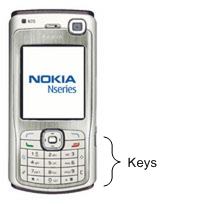Key events
Key events are generated when a device user presses one or more device key buttons. The application framework delivers the event to the application that has focus. The TKeyEvent structure is used to contain the key event details delivered to the application. For more information on TKeyEvent , see TKeyEvent .
The structure is as follows:
struct TKeyEvent
{
TUint iCode;
TInt iScanCode;
TUint iModifiers; // State of modifier keys
TInt iRepeats; // Count of auto repeats generated
};
The following events are generated by means of a single key press and release:
EEventKeyDown
EEventKey
EEventKeyUp
The first event indicates that a key has been pressed down. The second event indicates that a character has been received from the keyboard. The third event is sent when the button has been released. These events are described in the iCode and iSCanCode members of TKeyEvent .
For more information on possible data contained in EEventKey , see TKeyCode .
Key presses may be interpreted by a Front End Processor (FEP) and tied to specific key events. For example, if a device user presses the 2 key twice, an active FEP could generate a key event code of b .
For more information on FEPs, see Front End Processor overview .
Copyright ©2010 Nokia Corporation and/or its subsidiary(-ies).
All rights
reserved. Unless otherwise stated, these materials are provided under the terms of the Eclipse Public License
v1.0.
